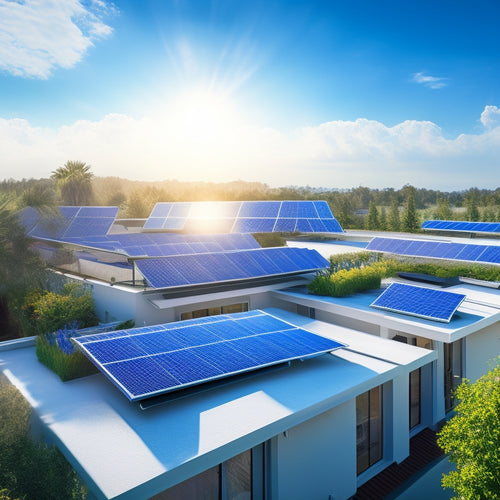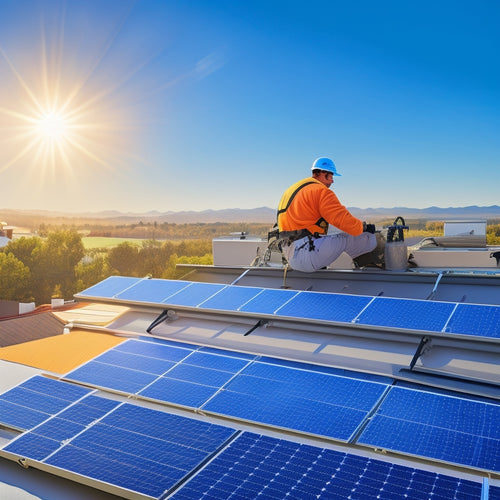
A 10-Step Guide to Home Solar Panel Installation
Share
You're about to initiate a life-changing expedition to utilize the power of the sun, and a well-planned home solar panel installation is the key to revealing significant energy savings and a reduced carbon footprint. Start by evaluating your solar needs, inspecting your roof's condition, and selecting the right panel type for your setup. Then, choose inverters and mounts, obtain necessary permits, and prepare your home's electric system for the installation. As you traverse the process, it's essential to reflect on installation costs, grid connection, and system performance monitoring. With each step, you'll be one step closer to reaping the rewards of renewable energy - and there's even more to uncover as you continue on this path.
Key Takeaways
- Assess your solar needs by defining energy goals, analyzing consumption patterns, and evaluating budget and environmental impact.
- Ensure your roof is in good condition by inspecting for damage, evaluating surface durability, and confirming structural integrity.
- Choose the right solar panel type by comparing monocrystalline, polycrystalline, and thin film options based on energy output, lifespan, and cost.
- Obtain necessary permits and ensure building code compliance by gathering documentation, submitting applications, and meeting local zoning regulations.
- Regularly monitor system performance, track energy production, and schedule maintenance to optimize energy savings and minimize issues.
Assessing Your Solar Needs
As you consider shifting to solar energy, evaluating your solar needs is an important first step. You'll want to define your solar energy goals, considering how much energy you need to generate and how you plan to use it.
Budget considerations are also vital, as you'll need to determine how much you're willing to invest upfront and what financing options are available. Don't forget to think about the environmental impact of your decision, as well as any local incentives that may be available to you.
Next, you'll need to conduct an energy consumption analysis to determine your energy usage patterns. This will help you size your solar panel system correctly.
Think about future expansion, too - will you need to add more panels in the future? Finally, consider the technology advancements and installation timeline, as well as ongoing maintenance costs.
Evaluating Roof Condition
During the planning stages of your home solar panel installation, assessing your roof's condition is a critical step that can't be overlooked. As you prepare to utilize the power of the sun, it's crucial to verify your roof can support the weight and durability requirements of solar panels.
Conduct a thorough roof inspection to identify any damage, wear, or potential issues that could affect the performance and longevity of your solar panel system. Check for signs of aging, such as curled, buckled, or missing shingles, and inspect flashing around chimneys, vents, and skylights for gaps or cracks.
Assess the surface durability of your roof, taking note of its material, age, and condition. You'll want to take into account factors like roof pitch, orientation, and shading, which can impact the performance of your solar panels.
Additionally, confirm your roof is structurally sound and can support the added weight of the solar panel system. By evaluating your roof's condition, you'll be able to identify and address any potential issues before installation, guaranteeing a successful and efficient solar panel system that meets your energy needs.
Choosing Solar Panel Type
With your roof condition assessed, you're now ready to decide on the type of solar panel that's right for you. Three primary options exist: monocrystalline, polycrystalline, and thin film.
Monocrystalline panels boast high energy output and long lifespan (up to 30 years), but come at a higher cost. Polycrystalline panels offer similar efficiency at a lower price point, making them a popular choice. Thin film panels are the most affordable, but their lower efficiency and shorter lifespan (around 20 years) make them less desirable.
When choosing a solar panel type, consider energy output, cost, and environmental impact. Compare the energy output of each type to determine which best suits your energy needs.
Conduct a cost analysis, assessing the upfront cost against long-term savings. Additionally, consider the environmental impact of each option, as well as installation requirements, warranty considerations, and aesthetic options.
Selecting Inverters and Mounts
Now that you've selected the ideal solar panel type, it's time to focus on the components that convert and facilitate the flow of solar energy.
You'll need an inverter to convert DC power from your solar panels to AC power for your home. There are three main inverter types: string inverters, microinverters, and power optimizers. String inverters are the most common and cost-effective option, while microinverters provide more granular control and monitoring. Power optimizers offer a compromise between the two.
When selecting an inverter, consider factors like efficiency, durability, and compatibility with your solar panel system.
You should also choose a mounting system that securely fastens your solar panels to your roof or ground. Mount materials like aluminum, stainless steel, and anodized aluminum are durable and corrosion-resistant.
Confirm your mounting system is designed for your specific roof type and can withstand local weather conditions. A well-chosen inverter and mounting system will guarantee a reliable and efficient flow of solar energy to your home.
Obtaining Necessary Permits
You'll need to secure permits from your local government before installing your home solar panel system, so it's crucial to understand the permit application process.
This process typically involves submitting plans and specifications for your system, which must comply with local building codes and regulations.
Permit Application Process
Your solar panel installation project requires a green light from local authorities, and that's where the permit application process comes in. This process involves submitting your project plans and documentation to the relevant authorities, who will review them to guarantee compliance with local regulations and zoning laws.
Permit Application Process Overview
| Step | Description |
|---|---|
| 1. Documentation | Gather required documents, including system design, electrical diagrams, and roof plans |
| 2. Application Submission | Submit your application, including all necessary documents and fees |
| 3. Plan Review | Authorities review your application to guarantee compliance with local regulations |
| 4. Inspection and Approval | Schedule an inspection, and receive approval once your project passes |
During the application process, you'll need to pay permit fees, which vary depending on your location. Be prepared for an approval wait time, which can take several weeks. As a homeowner, it's your responsibility to guarantee that your project complies with local regulations and to renew your permit as required. Understanding the permit application process will help you maneuver this vital step in your solar panel installation project.
Building Code Compliance
The expedition to a successful solar panel installation project involves more than just selecting the right equipment and finding a reputable installer; it also requires compliance with local building codes and regulations.
You'll need to confirm that your installation meets zoning regulations, safety standards, and installation guidelines to avoid any potential issues. This includes verifying the structural integrity of your roof to support the weight of the solar panels.
Additionally, you'll need to comply with local ordinances, which may include energy efficiency and environmental impact assessments. Your installer should also meet utility requirements and pass inspection procedures to assure a safe and functional system.
Obtaining necessary permits is essential to avoid fines, penalties, or even system shutdown.
You'll need to gather compliance documentation, including permits, certificates, and inspection reports. Your installer should provide you with these documents, confirming that your system is installed to code.
Preparing Your Home's Electric
Electricity meters ticking away on your exterior walls indicate that your home's electric system is already set up to receive power from the grid.
Now, it's vital to prepare your home's electric system for solar panel installation. Start by evaluating your energy consumption patterns to identify areas for power optimization.
You may need to invest in electrical upgrades to guarantee your system can handle the additional power generated by solar panels. Safety measures are significant, so inspect your wiring and electrical connections to make sure they're up to code.
A thorough load evaluation will help you determine the maximum amount of power your system can handle.
Don't forget to take into account utility interaction, as you'll need to facilitate a smooth shift between grid power and solar-generated power.
Installing Solar Panels
With your home's electric system optimized, it's time to bring solar power into the mix. This is the most exciting part of the process – installing the solar panels that will utilize the sun's energy to power your home. You've made it this far, and now it's time to reap the solar energy benefits.
Before we plunge into it, let's take a look at the installation costs and what you can expect:
| Installation Component | Average Cost |
|---|---|
| Solar Panels | $15,000 - $20,000 |
| Mounting Hardware | $2,000 - $5,000 |
| Inverters | $1,000 - $3,000 |
| Electrical Wiring | $1,000 - $2,000 |
| Permits and Inspections | $1,000 - $2,000 |
Your installation team will arrive on site, equipped with the necessary tools and equipment to get the job done. They'll assess your roof's condition, ensuring it can support the weight of the solar panels. Then, they'll install the mounting hardware, followed by the solar panels themselves. With the panels in place, the team will connect the inverters and electrical wiring, completing the installation.
Connecting to the Grid
As you prepare to harness the power of the sun, connecting your solar panel system to the grid is an essential step in feeding excess energy back into the utility grid and offsetting your electricity bills.
To guarantee a seamless grid connection, you'll need to comply with utility regulations and enter into an interconnection agreement with your utility company. This agreement outlines the terms and conditions for connecting your system to the grid, including safety standards and system integration requirements.
Through net metering, you'll earn energy credits for the excess energy your system produces, which can be used to offset your energy consumption during periods of low sunlight.
To promote power flow and utility communication, your system must meet specific safety standards and grid stability requirements. Your installer will verify that your system is properly integrated and configured to meet these requirements.
Monitoring System Performance
You'll want to keep a close eye on your solar panel system's performance to guarantee it's operating at its best.
This means tracking system performance, analyzing energy output, and monitoring real-time data to identify areas for improvement.
System Performance Tracking
By the time your solar panel system is up and running, you'll want to keep a close eye on its performance to confirm it's generating electricity efficiently. This is where system performance tracking comes in.
You'll need to monitor your system's performance metrics to identify areas for optimization and make sure you're getting the most energy savings possible. Efficiency tracking will help you pinpoint any issues that might be reducing your system's output.
Using data visualization tools, you'll be able to see usage patterns and identify opportunities to adjust your energy consumption habits.
Regular maintenance scheduling will also be essential to prevent issues from arising in the first place. If any problems do occur, you'll be able to quickly troubleshoot and resolve them.
Performance forecasting will allow you to anticipate and prepare for any changes in energy production.
Energy Output Analysis
Three key metrics form the foundation of energy output analysis: total daily energy production, peak sun hours, and capacity factor. These metrics help you understand your solar panel system's performance and identify areas for improvement.
Total daily energy production measures the actual energy generated by your system, while peak sun hours indicate the maximum potential energy output under ideal conditions. The capacity factor, a ratio of actual to potential energy production, reveals your system's efficiency.
You can use this data to optimize your energy consumption and storage. By monitoring your energy output, you can adjust your usage patterns to maximize your solar efficiency and reduce your reliance on the grid. This, in turn, minimizes your environmental impact and increases your savings from financial incentives.
Regular analysis also helps you identify potential issues, allowing you to schedule maintenance and plan for system upgrades. Additionally, understanding your energy output enables you to make informed decisions about energy storage solutions, reducing your installation costs and enhancing your grid independence.
Real-time Data Monitoring
Most solar panel systems come equipped with a monitoring system that provides real-time data on your energy production. This monitoring system allows you to track your solar performance in real-time, giving you a clear understanding of how much energy your system is producing at any given moment.
With real-time analytics, you can identify any issues or inefficiencies in your system, allowing you to take prompt action to optimize its performance.
You'll be able to view detailed reports on your energy production, including the amount of energy produced, the amount of energy consumed, and the amount of energy exported back to the grid. This data will help you fine-tune your energy usage, making adjustments to maximize your savings and minimize your carbon footprint.
Moreover, many modern monitoring systems offer remote access, allowing you to check on your solar performance from anywhere, at any time. This feature is particularly useful if you have a vacation home or rental property with solar panels.
Maintaining Your Solar System
As you take satisfaction in your newly installed solar system, remember that regular maintenance is crucial to guaranteeing its best performance and extending its lifespan.
To get the most out of your system, follow these solar maintenance tips: conduct routine inspections to identify potential issues, and clean your panels regularly to guarantee peak energy production.
Troubleshoot any issues promptly to prevent minor problems from becoming major ones. Be certain to review your warranty considerations to understand what's covered and what's not.
Don't forget to schedule inverter servicing and battery upkeep to keep your system running smoothly. Consider system upgrades to enhance performance and take advantage of seasonal adjustments to maximize energy production.
By staying on top of maintenance, you'll be able to enhance your system's performance, reduce energy bills, and enjoy the long-term benefits of renewable energy.
Stay proactive, and your solar system will continue to power your home efficiently for years to come.
Frequently Asked Questions
Can I Install Solar Panels on a Metal or Clay Tile Roof?
Like a knight preparing for battle, you're gearing up to conquer energy independence, but first, you wonder if your metal or clay tile roof is compatible with solar panels - rest assured, with careful installation considerations, you can utilize the power of the sun.
Will Solar Panels Increase My Home's Value and Selling Price?
You're likely to see a significant investment return, as solar panels enhance your home's value and selling price, aligning with market trends that favor eco-friendly features, making your property more attractive to environmentally conscious buyers.
Are There Any Government Incentives for Solar Panel Installation?
You'll be pleased to know that, yes, government incentives for solar panel installation exist, and you can tap into federal tax credits and state rebates, considerably reducing your upfront costs and maximizing your return on investment.
Can I Add More Solar Panels to My Existing System Later?
You can easily expand your existing system later, but you'll need to take into account system expansion costs, which may be higher than your initial installation costs, so it's crucial to plan and budget accordingly to maximize your energy output.
Will Solar Panels Still Generate Power During a Blackout?
During a blackout, you'll still generate power with solar panels, but only if you have an off-grid system or battery storage - otherwise, your system will shut down for safety reasons, ensuring you don't feed electricity back into the grid.
Related Posts
-

Master Advanced Solar Panel Design Online for Free
You can master advanced solar panel design online for free by leveraging specialized courses and training platforms, ...
-

Best Solar Panel Options for Maximum Energy Savings
You can maximize your energy savings with solar panels that boast efficiency ratings above 20%, paired with extensive...
-

3 Essential Steps for Solar Electricity Installation
To guarantee a successful solar electricity installation, you'll need to follow three essential steps. First, assess ...


